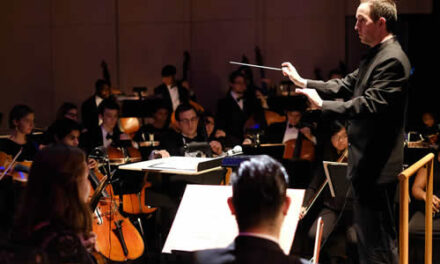With flair and a flourish, the Ciompi Quartet ended its regular season in Nelson Auditorium with a memorable performance both for programming and technical polish. Their aim this last season to introduce a premiere of a new work every concert (only marred by a tardy composer in one case) was laudable, and this last one was the most fun-if not the best of the lot.
They started with what has for them become the customary Haydn quartet from that seemingly inexhaustible well. They chose one of his most innovative ones, the Quartet in f-sharp minor, Op.50, No.4, a key rarely used at the time. In fact, minor keys in general were avoided unless the composer had something particularly intense, or even tragic, to say. Cellist Fred Raimi’s program notes were a little exaggerated in describing this work as delving “into anxiety, obsession and schizophrenia,” but the Ciompi’s interpretation was appropriate for this example of Sturm und Drang. Nowhere was this more apparent than in the second movement andante where the gentle opening theme is suddenly interrupted by a violent middle section. There were times, however, especially in the opening movement where their aggressive interpretation was unremittingly forte and overworked.
The premiere of the evening was the String Quartet No. 2 by Nathaniel Stookey, entitled “Musée Mécanique” (Mechanical museum) for a game arcade in San Francisco where Stookey used to hang out as a kid. The Quartet was one of those rare pieces that are intended to be unabashedly playful and even funny. Each movement recalled a piece of machinery, or gadget, and were so entitled: Chaser, Plucker, Opener, Grinder and Mixer (three more and you would have had a new team for Santa.) While Stookey clearly intended the music to imitate the sound and/or function of the gadget, only in the first and second movements was the imitative affect really clear. Chaser was composed as a piece of neo-Baroque imitative counterpoint, and Plucker was-obviously- a pizzicato movement. Grinder suggested a “bump-and-grinder” with its bluesy style and Mixer was just a grab-bag of musical styles and gestures. The times when the tone painting was not immediately obvious, however, didn’t attenuate the humor. All the movements were some kind of perpetual motion that “turns on and off” as with a power switch; except for the final one, they simply stopped-mid-phrase, mid-bow, whatever. The Ciompi threw themselves into it and were clearly having a great time. And the audience loved it. Seldom have we heard such enthusiasm after even the most accessible contemporary works.
The program ended with a riveting performance of Beethoven’s Quartet in F Major, Op.135. This final chapter of Beethoven’s creativity abandons the structural experiments of the other four so-called “late quartets” and returns to the traditional Haydnesque four-movement structure. Not that it lacks emotional intensity, but it is packaged in a more traditional way. In some respects the Quartet No. 135 matches the earlier work by Haydn since both of them employ significant mood swings-unusual for Haydn but to be expected in Beethoven’s late works. The Ciompi performed it with impeccable intonation and timing, bringing out both the sunnier and darker sides of the work.











